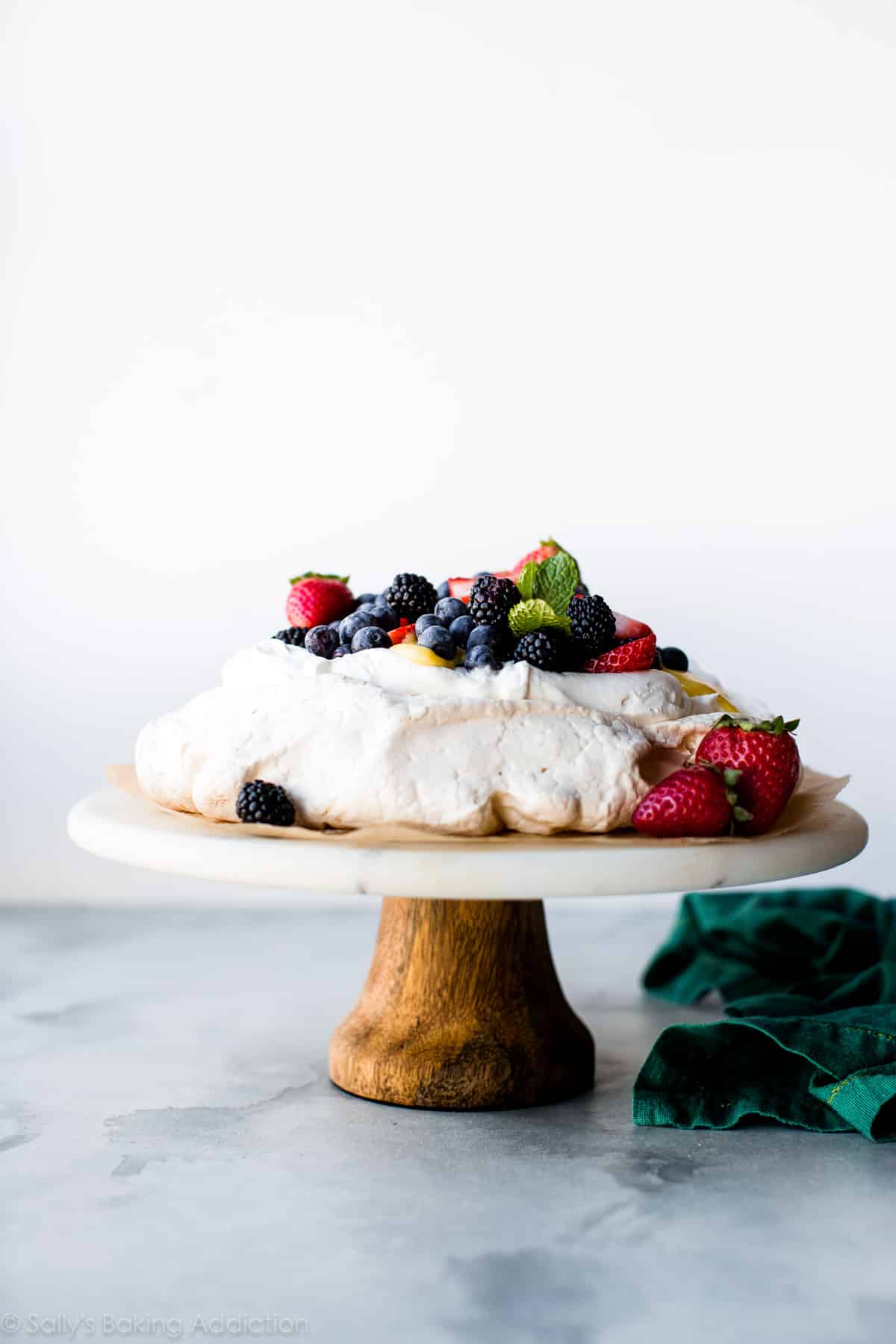
Another fresh and exciting recipe for you!
What is pavlova? Pavlova is a dessert popular in New Zealand and Australia. It’s not as common here in the states, but I hope to help change that! A texture lover’s dream come true, pavlova is made from egg whites that are slowly baked in a relatively cool oven. The egg whites take on a chewy-crisp texture on top, a soft marshmallow texture inside, and a crunchy crisp texture around the edges. That’s three completely different textures in one single bite. The crunchy edges are just like meringue cookies.
Pavlova loves to be dressed up with assorted toppings, mainly fresh whipped cream and piles of fresh fruit. Naturally gluten free, pavlova is light, sweet, and screams warm weather favorite. Happy spring, my friends, we’re making PAVLOVA!!
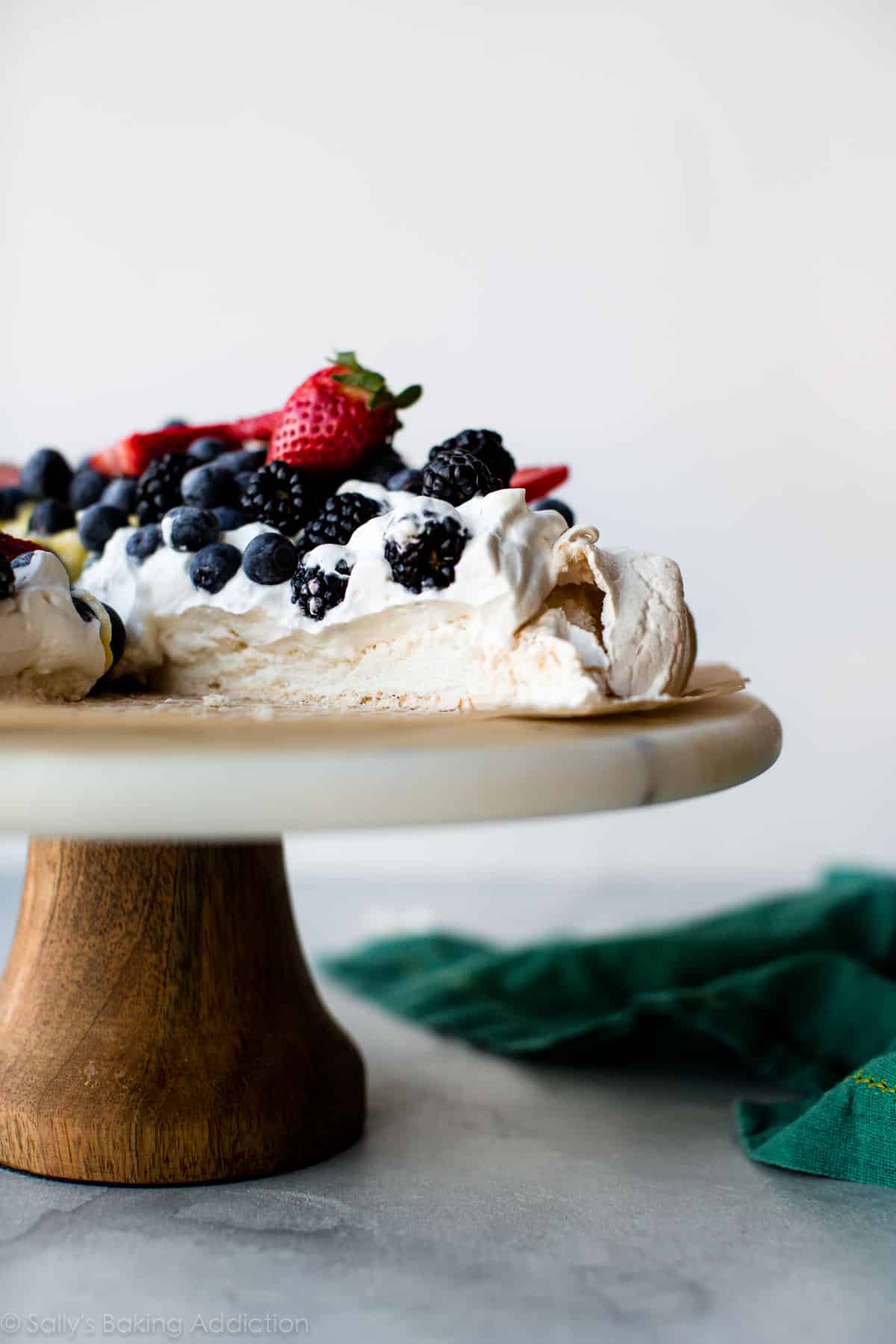
Video Tutorial: How to Make Pavlova
To obtain the unique pavlova texture, you must adhere to an exact recipe. While it’s fun to play around with ingredients, pavlova is not the time to stray from what’s listed. It’s picky, but picky doesn’t mean difficult. In fact, you only need 5 ingredients to make pavlova and I bet you have each in your kitchen right now:
- Egg whites
- Sugar
- An acid such as cream of tartar or vinegar
- Cornstarch
- Vanilla extract
Let me explain why these ingredients are used.
Pavlova Ingredients
- Egg whites – beaten into stiff peaks, egg whites are the base and volume of pavlova.
- Sugar – in addition to sweetening the dessert, sugar stabilizes the egg whites by holding them together both in the oven and as the whole pavlova cools. Without sugar, the protein molecules (science!) in egg whites will collapse. Additionally, sugar helps achieve the delightfully crisp texture. (Sugar is so much more than a sweetener in our baked goods.) Speaking of sugar, make sure that you use superfine or castor sugar. Just pulse sugar a few times in a food processor to reduce the size of the crystals.
- Acid – you can use 1/2 teaspoon of cream of tartar or 1 teaspoon white, apple cider vinegar, or even lemon juice. The pavlova will NOT taste like vinegar, I promise. The acid helps the egg whites hold onto air and, like the sugar, helps prevent the egg whites from collapsing. I tested with both and I actually prefer cream of tartar. I found that my pavlova spread a bit more when I used liquid acid.
- Cornstarch – I tested pav with and without cornstarch. I found that the center was fluffier and more marshmallow-y with cornstarch. Then I tested with 1 teaspoon cornstarch and 2 teaspoons cornstarch. I found it was a little chalky tasting with 2 teaspoons. I’m sticking to 1 teaspoon.
- Vanilla extract – purely for flavor!
(Not sponsored by any of these companies, but here’s exactly what I use.)
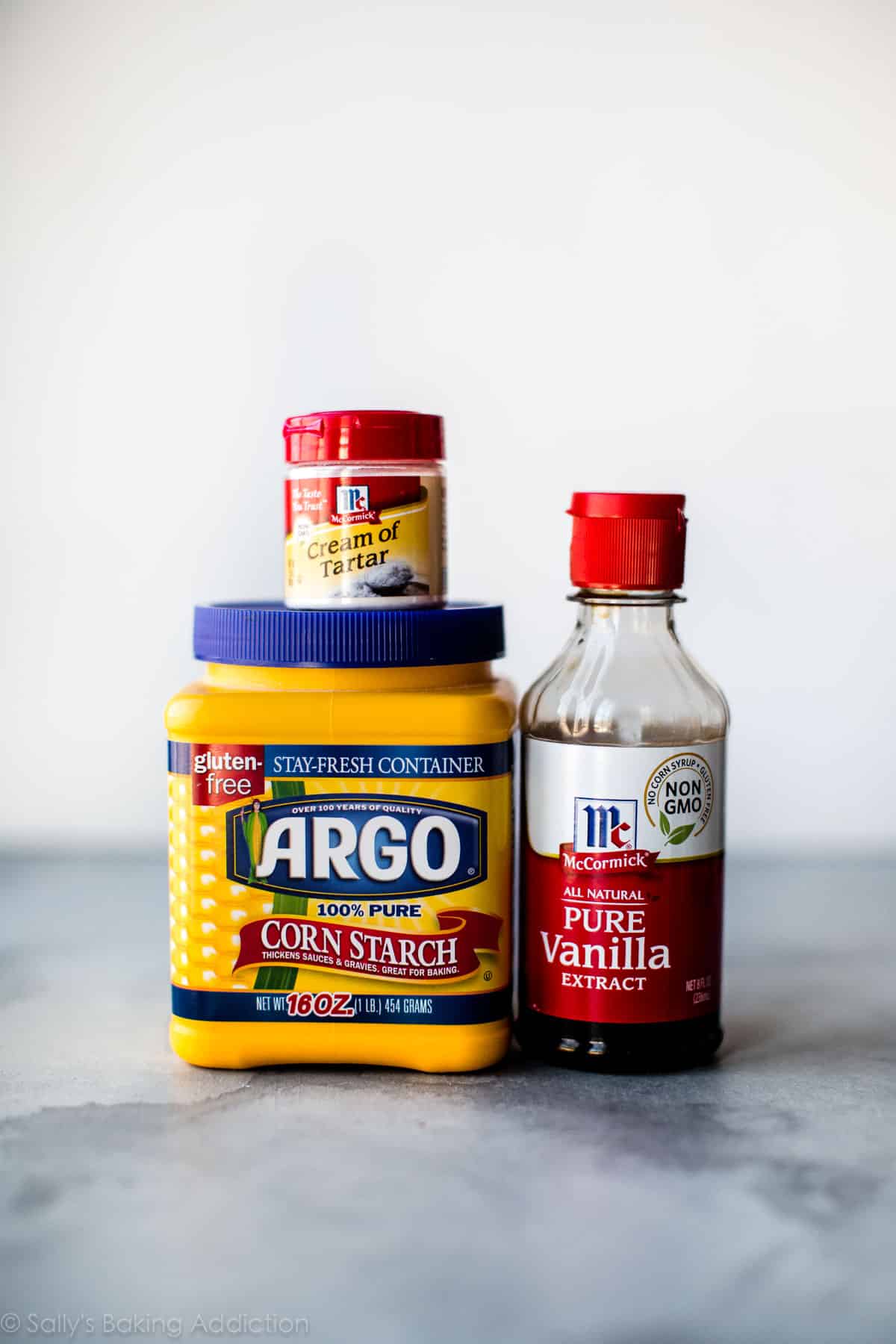
Ingredients are simple and method is effortless. There’s plenty of downtime when making pavlova. All you really have to do is watch it beat in your stand mixer then check on it in your oven. Kick your feet up!
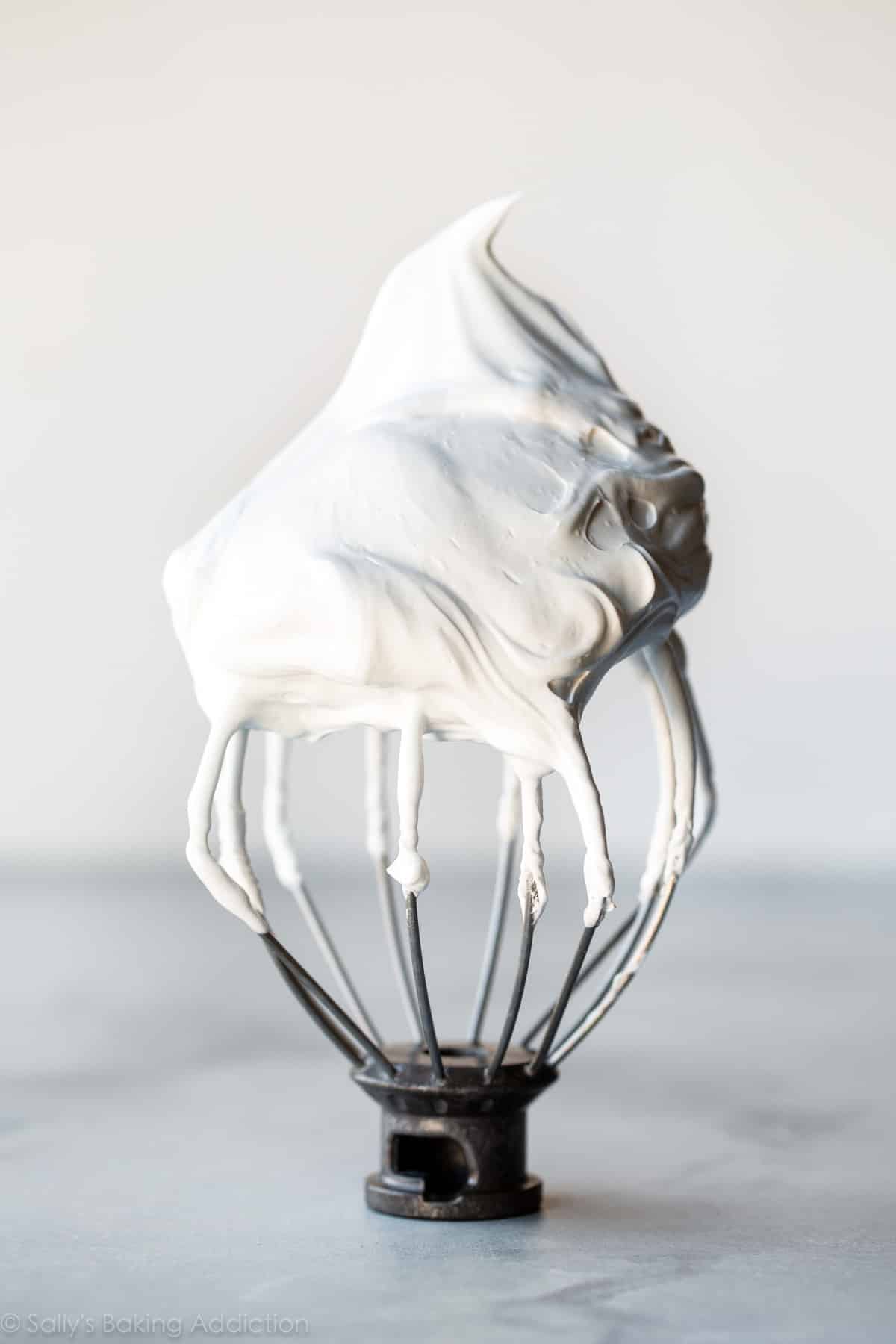
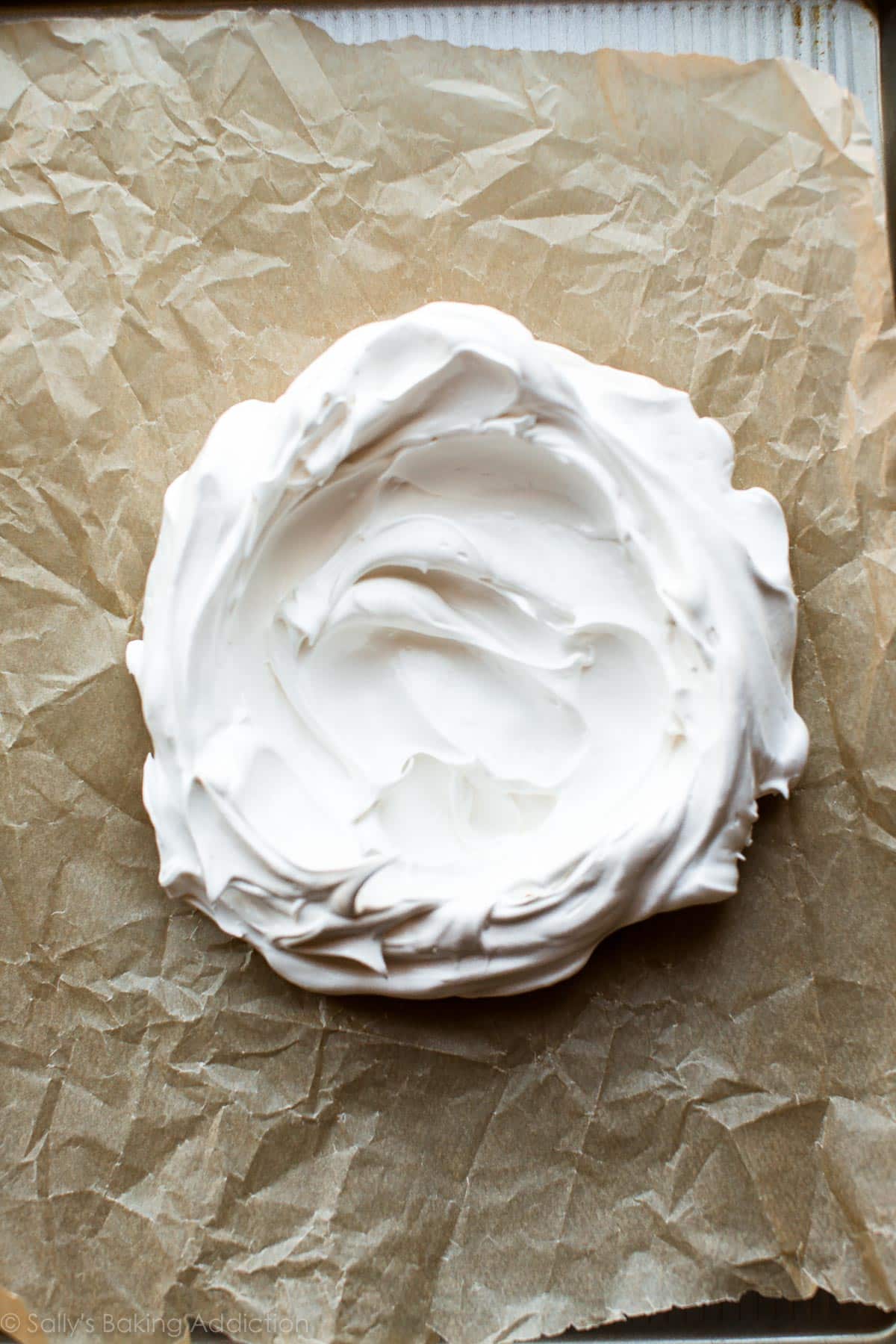
Just like our chocolate swirled meringue cookies and the meringue on our lemon meringue pie, whip the egg whites into super stiff peaks. Stiff enough that you can hold the whisk over your head and feel confident that the whipped egg whites won’t drop. 😉 Then you’ll spread the pavlova mixture onto your lined baking pan. You can use parchment paper or a silicone baking mat. Do not grease the baking pan—use a nonstick surface instead. Spread it into a circle, about 8-9 inches in diameter. You can eyeball it or trace one with a pencil. I just eyeball it. Like I did in the lemon meringue pie video, use the back of a spoon to create decorative peaks. Make sure the edges are tall and you have a nice dip in the center. That’s were we’ll pile our whipped cream and fruit!
Alternatively, you can make mini pavlovas. Here I piped the mixture into 6 mini pavlovas using Ateco 849. A piping tip isn’t necessary—you can just spoon it on. Again, make sure you leave a dip in the center to hold the toppings.
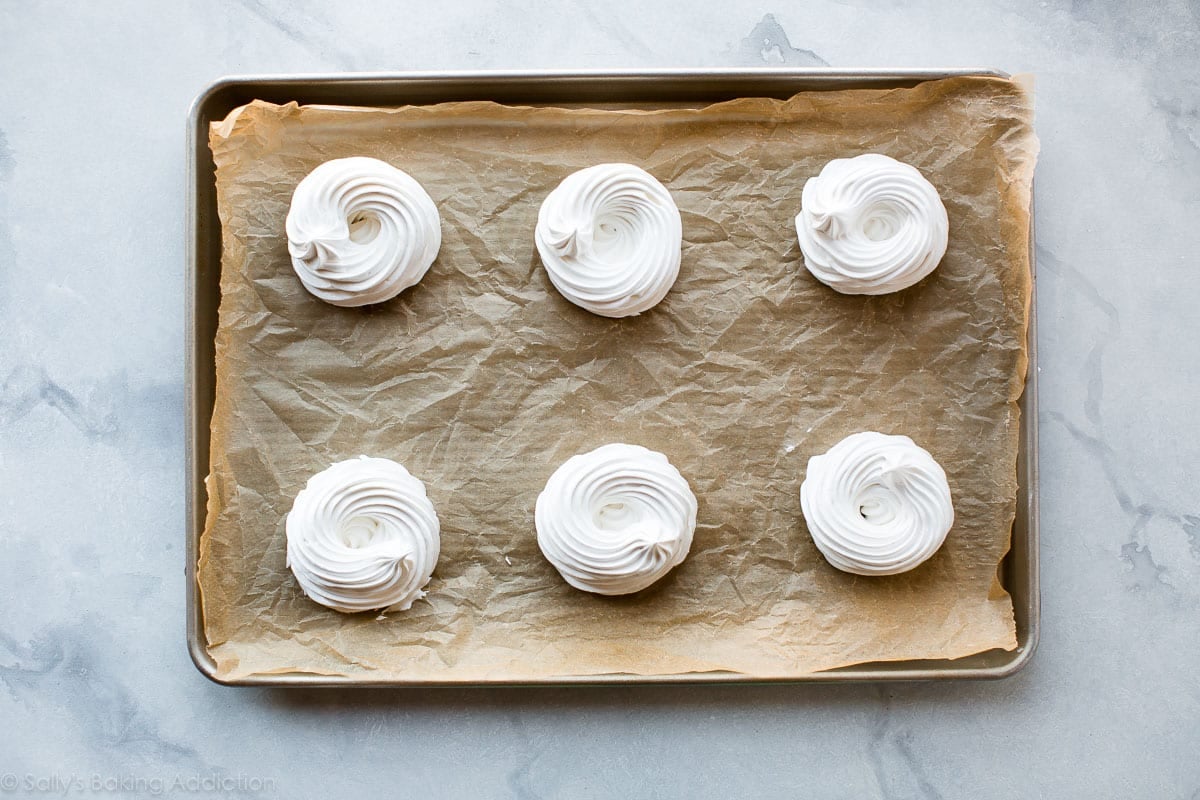
A relatively cooler oven is imperative for properly cooking your pavlova, but let’s start the pavlova at 350°F (177°C) then reduce it down to 200°F (93°C). I do this to help “set” the outer crust quickly. This trick helps reduce spread.
A properly cooked pav is pale in color. Cracks and bumps are par for the course, but the pavlova shouldn’t completely deflate. Especially if you follow the precise measurements and instructions in the recipe. You can help avoid too many cracks by cooling the pavlova in the oven. The sudden change of temperature (inside the oven to outside the oven) shocks the pavlova, so it’s best to cool inside the cooling oven.
Make sense?
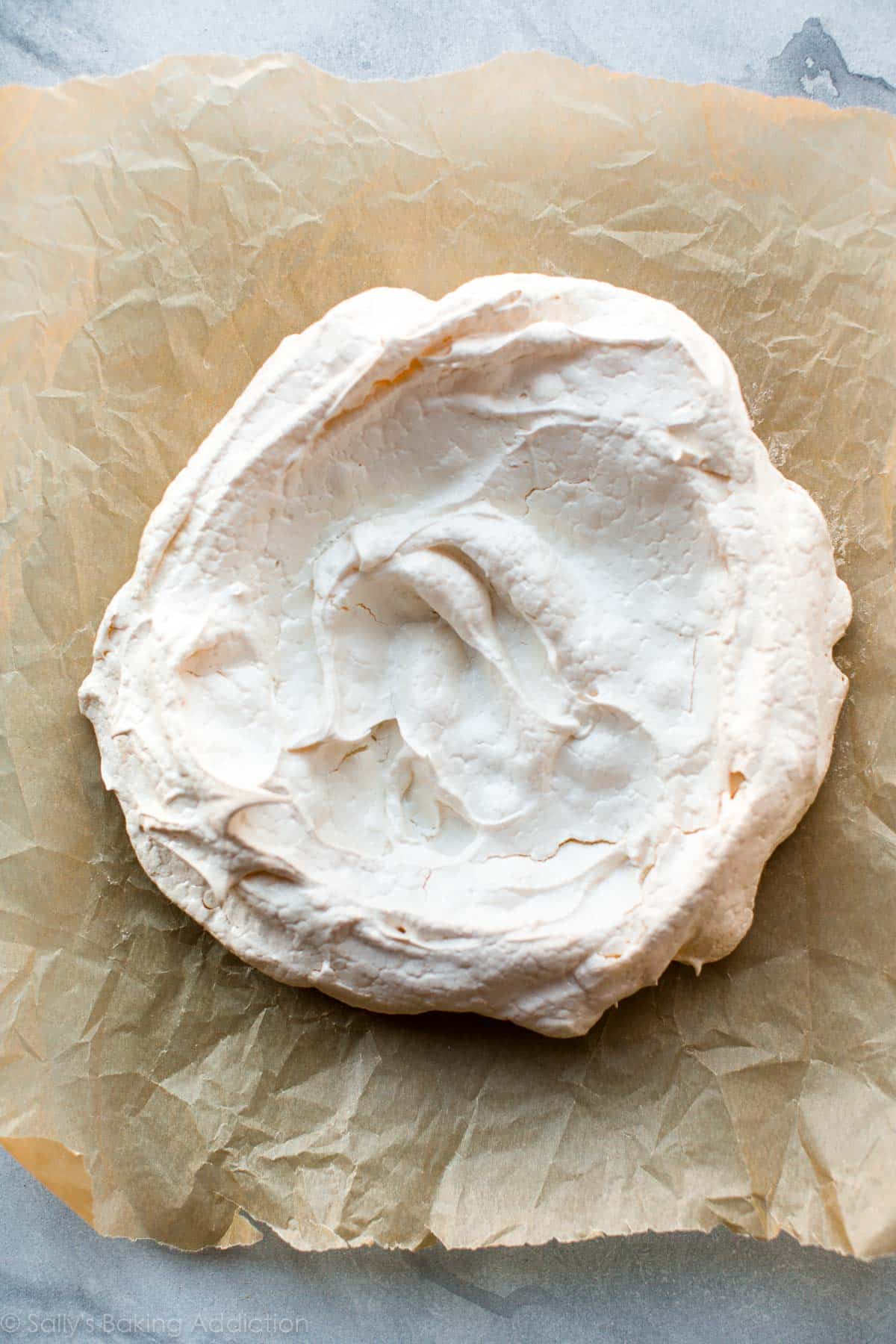
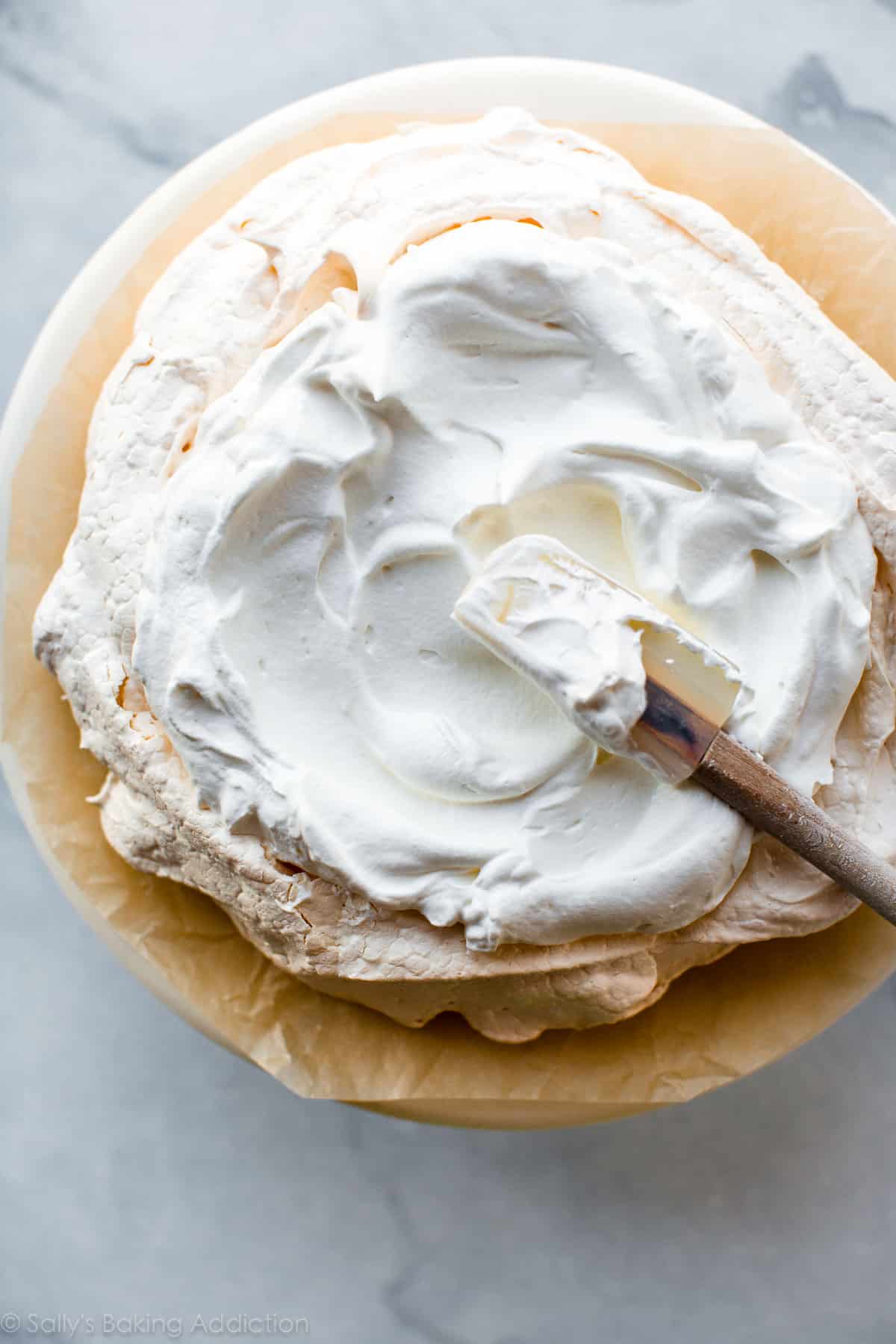
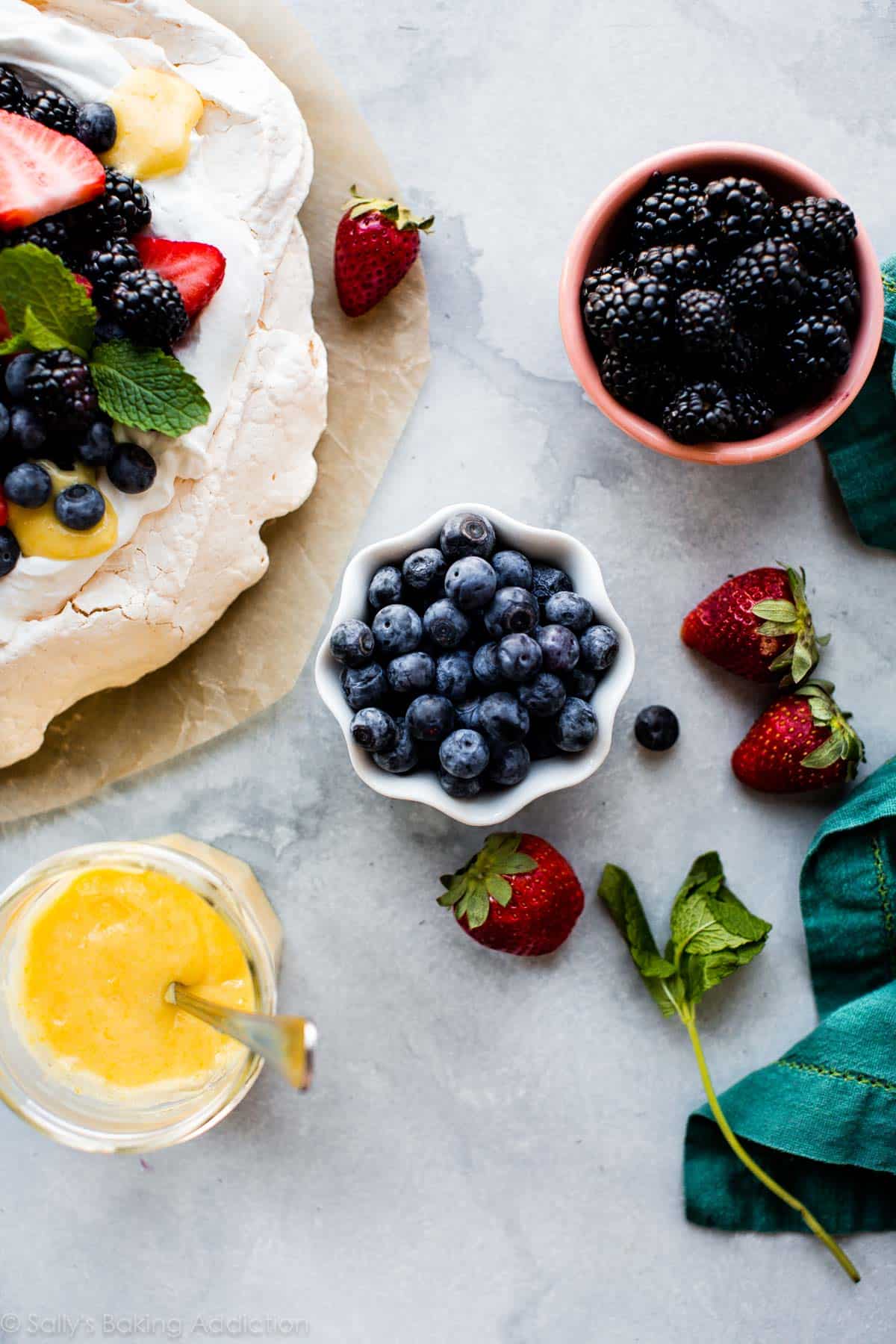
You can top your pavlova or mini pavlovas any which way, but here are some of my topping suggestions:
- Whipped cream is essential. You can get a little creative and flavor your whipped cream. Here are some fun flavored whipped creams.
- Homemade lemon curd. You’ll have exactly 4 egg yolks leftover anyway.
- A lot of fresh berries… enough to make a fruit pizza jealous!
- Edible florals and herbs
- Strawberry sauce, raspberry sauce, or blueberry sauce
- Chocolate shavings
- Seasonal fruits like mango, kiwi, passionfruit, blood oranges
No need to get artistic, just pile it all on top into a massive pavlova mountain.
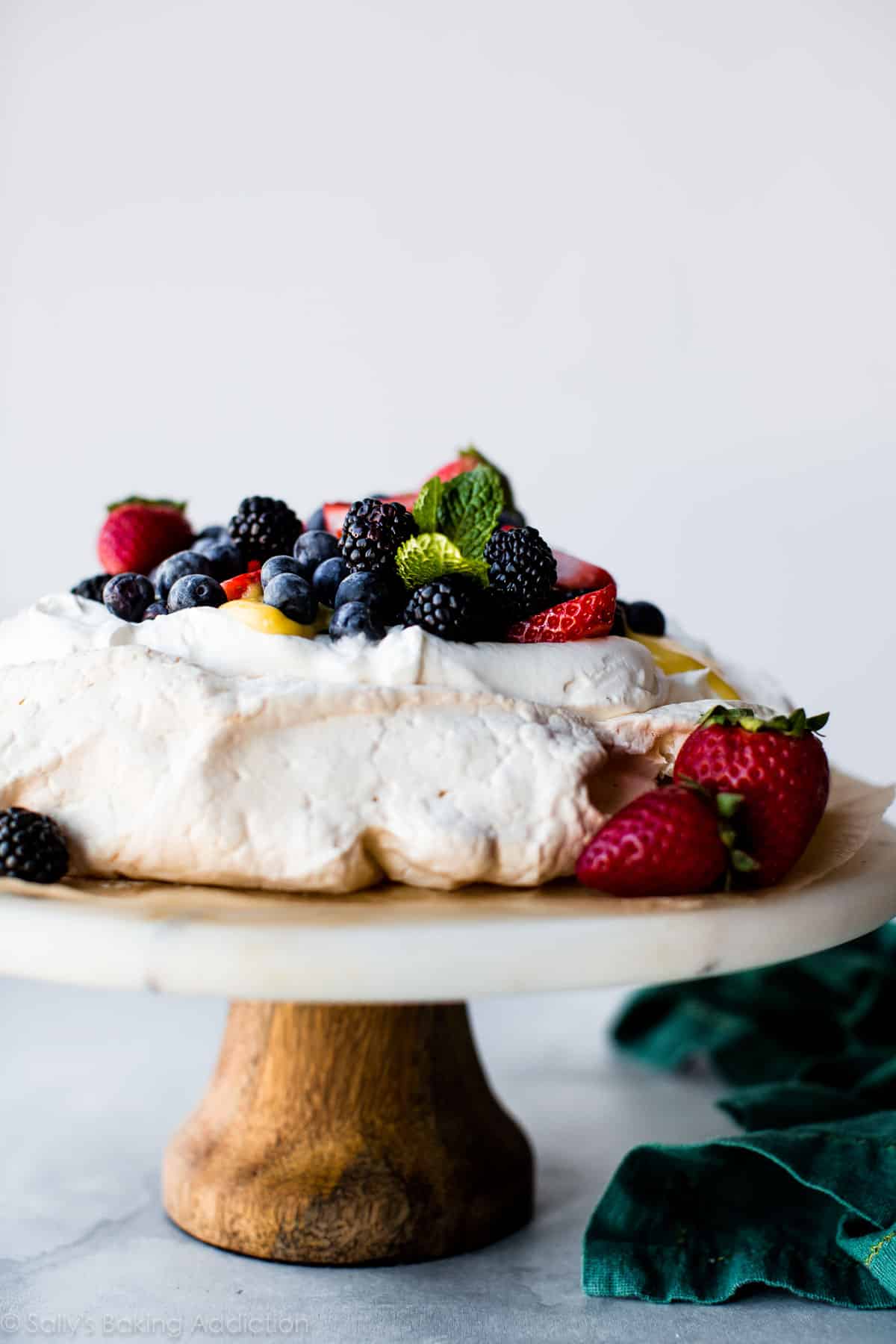
Things are bound to get a little messy when slicing, but if you cooked the pavlova long enough so that the bottom is crisp and the edges are set, it will hold a pie slice shape. This big thing serves about 8-10 people!
If you’re still on the fence about trying pavlova, might I remind you that the center tastes like marshmallows.
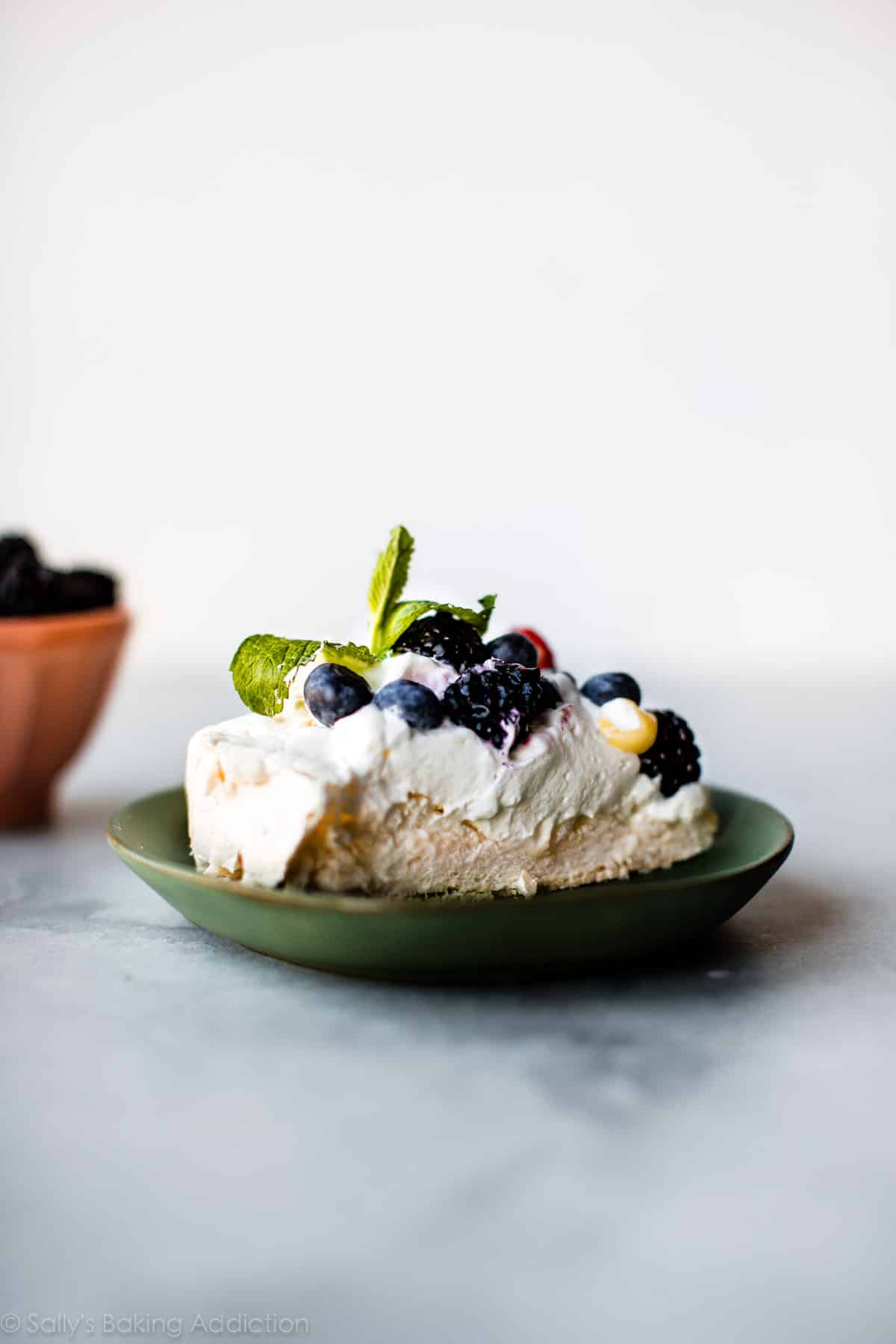
Have fun!
For more gluten-free baking inspiration, here are 40 gluten-free dessert recipes that are always a hit, including cranberry frangipane tart and flourless chocolate cake.
Print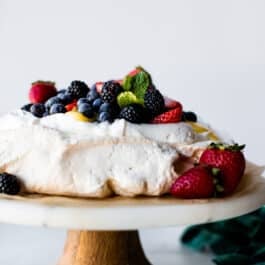
Pavlova
- Prep Time: 20 minutes
- Cook Time: 90 minutes
- Total Time: 4 hours
- Yield: serves 8-10
- Category: Dessert
- Method: Baking
- Cuisine: New Zealand
Description
Pavlova is crisp on the edges, chewy on top, and marshmallow soft and creamy in the centers. Pile high with lemon curd, whipped cream, and fresh fruit to make a naturally delicious gluten free dessert!
Ingredients
- 4 large egg whites (use the yolks for lemon curd!)*
- 1 cup (200g) superfine sugar*
- 1 teaspoon pure vanilla extract
- 1/2 teaspoon cream of tartar*
- 1 teaspoon cornstarch
Toppings
- Homemade whipped cream, fresh fruit, strawberry topping, lemon curd, or any desired topping (see post for suggestions)
Instructions
- Preheat the oven to 350°F (177°C). Line a large baking sheet with parchment paper or a silicone baking mat. (Preliminary note: you will quickly reduce the oven to 200°F (93°C) in step 4.)
- With a handheld mixer or a stand mixer fitted with a whisk attachment, beat the egg whites on medium-high speed until soft peaks form, about 5 minutes. Add the sugar in 2 additions, beating for 30 seconds between. Once all of the sugar has been added, turn the mixer up to high speed and continue beating until glossy stiff peaks form, about 2 minutes. The peaks should be stiff enough that you can hold the whisk upright and the peaks won’t move. Add the vanilla extract and beat for 1 more minute. The peaks should still be very stiff. If not, keep on mixing on high speed. Using a rubber spatula, fold in the cream of tartar and cornstarch.
- Spread the pavlova mixture into an 8-9-inch circle (see note for mini size). You can make decorative peaks with the back of a large spoon if desired. Make sure the edges are relatively tall and there is a nice dip in the center.
- Place pavlova in the oven. As soon as you close the oven door, reduce heat to 200°F (93°C). The pavlova will stay in the oven as it cools down to 200°F (93°C). Bake until the pavlova is firm and dry, about 90 minutes total. Rotate the baking sheet if you notice some spots browning. Try to limit how many times you open the oven as the cool air will interrupt the baking.
- Turn the oven off and let the pavlova cool inside the oven. Once the pavlova is cool, you can store it covered at room temperature for up to 2 days. Or serve right away.
- Once cool, top the pavlova with whipped cream and assorted toppings. Slice and serve.
Notes
- Make Ahead Instructions: See step 5 for making the pavlova in advance. Pavlova is best enjoyed right after it’s garnished. It doesn’t freeze well.
- Special Tools (affiliate links): Electric Mixer (Handheld or Stand) | Baking Sheet | Silicone Baking Mat or Parchment Paper | Marble Cake Stand or Serving Platter
- Egg Whites: (1) Room temperature egg whites whip faster than cold egg whites. And (2) room temperature egg whites whip into a greater volume than cold egg whites. So make sure your egg whites are at room temperature before beginning.
- Sugar: Superfine sugar dissolves easier into egg whites. To avoid tasting sugar granules, pulse 1 cup granulated sugar a few times in a food processor. You now have superfine sugar to use in the recipe.
- Acid: You can use 1/2 teaspoon of cream of tartar or 1 teaspoon of white vinegar, apple cider vinegar, or lemon juice.
- Mini Pavlovas: Divide pavlova mixture up into individual portions instead of spreading into one large 8-9-inch circle. In the photos, I piped the mixture into 6 mini pavlovas using Ateco 849. A piping tip isn’t necessary—you can just spoon it on. Make sure you leave a dip in the center to hold the toppings. Bake time depends on size, see step 4 for what to look for. If making 6 mini pavlovas like I did, bake for 35-40 minutes at 200°F (93°C). Start them in a 350°F (177°C) oven, like I do in this written recipe.
- Pavlova base from reader Laurel. Thanks, Laurel!



















I’m interested in making a chocolate one topped with raspberries. How much cocoa would I need and would there be any other adjustments?
Hi Eileen, we haven’t experimented with a chocolate variation, so we’re unsure what tweaks would be needed. Let us know if you try anything!
The recipe was great and very easy to follow. I used lemon extract on account if not having vanilla and it came out pretty good lemon flavoured. I have made pavlova before but this was by far the easiest recipe to follow. My grandma really liked it too! Thanks for the great recipes Sally
This was a big hit at the party we went to. No one had ever had it. Even the kids loved it!
I attempted to follow this recipe exactly and thought I had done well. It looked absolutely perfect until I tried to get it off of the cookie sheet and it completely fell apart 🙁 it was impossible to get it off the sheet without it cracking and separating, and now it looks too messy to serve. It seemed a bit wet on the inside as well. Any ideas what went wrong? I only opened the oven once to rotate it during baking, then left it in the oven overnight to fully cool down. I did notice some moisture in the oven in the morning, wondering if it got too humid in there? My
oven also has frustratingly vague temperature settings. I try to use an oven thermometer to be sure but maybe the oven wasn’t quite hot enough after I turned it down to 90°C. Any advice would be greatly appreciated. Thank you!
It sounds like you missed the step of putting parchment paper down on your baking pan. The paper helps tremendously
Make an Eaton Mess from it, if it fails again. Just put pieces in a parfait glass with whipped cream, and top with fruit. However, I grease my parchment paper very lightly. Seems to work.
Hey Sally! I’m curious if this recipe could be easily cut in half. I want to make a smaller pavlova using only two egg whites. Would I just cut every other ingredient by half as well?
Hi Gilliann, yes, you can halve the recipe. We’re unsure of the exact bake time. It’s done when it feels firm and dry. Hope you love it!
Wondering if I could mix the lemon curd in with the whipped cream to top the pavlova and then berries on top? Would the curd be too heavy for the cream? And would the pavlova hold it all without falling in? Think that would be a nice combo if doable.
Hi Kelli! Yes, you can mix the two together. Here’s a nice tutorial for that: https://cheflindseyfarr.com/lemon-whipped-cream-2/
Can the cornstarch be substituted for anything else? Corn allergy in the house.
Hi Stacey, we haven’t tested this recipe with any cornstarch alternatives. Potato starch may be an option, but again, we haven’t tried it ourselves to know the outcome. It may be best to find a recipe specifically written to be corn-free. Let us know if you try anything!
Just leave out the cornstarch. I made it for years with a recipe that didn’t call for it. I didn’t see a huge difference.
Try using tapioca instead.
Turned out perfect! Lemon curd as well. The only substitute was tapioca instead of crème of tartar but worked out no problem, picture perfect and tasted like heaven
I made this yesterday for the first time for a customer. She said it was amazing. Thanks Sally.
Can I use less sugar in the pavlova?
Hi MaryAnn, Without the full amount of sugar in this recipe, the egg whites would deflate and you wouldn’t get the crisp exterior. We don’t recommend reducing the amount.
This recipe came out perfect, or should I say ‘parfait’? Was very much like the pavlovas my wife and I shared in Paris recently. Thank you for sharing it.
I have never made any sort of meringue and decided to try this. I followed everything and it turned out incredible. There were a couple of comments that mentioned that this was very sweet. For the whipped cream I followed the recipe on this site but used only a tea spoon of sugar, this balanced this in a way that everyone who tried it enjoyed. It was the perfect warm weather dessert, thank you.
No matter what I do (I’m on round 3), my egg whites peak up fine, but when I add sugar, it becomes completely runny and no matter how long I beat it, it won’t stiffen up again. Any idea of what I might be doing wrong?
Hi Britt, We are happy to help troubleshoot. Make sure that you are using superfine or castor sugar and you can try adding it in more slowly instead of just in two additions. You can also try turning up the speed on the mixer– you may just need a faster whip. Additionally, try wiping down your mixing bowl and the whisk attachment with a *little* lemon juice before starting. This will help rid any grease residue that could be preventing the mixture from reaching stiff peaks. Hope this helps!
My favorite dessert for summer! If I follow the recipe to the T, the pavlova is just perfect.
I love your blog and have been making your recipes for years :)…this, for me, was way too sweet. I’m wondering if the texture would be the same with less sugar? I think I’ll 1/2 the sugar next time.
Hi Jeniva, thanks so much for making and trusting our recipes! Without the full amount of sugar in this recipe, the egg whites would deflate and you wouldn’t get the crisp exterior. Maybe try a topping that isn’t as sweet for him to help offset the sweetness in the pavlova.
I have made this many, many time, sometimes in little cookies, as well, but I use powdered sugar. No grinding, no grit, mixes instantly and it seems to mix better with dryer results. Perhaps give that a try, adding it when the egg whites are just beginning to thicken. Could you be over beating the eggs. I have read that they fall apart if you do so.
Could you be over beating the eggs? They will fall apart and become watery if over beaten. I have made this many, many times, sometimes in little cookies, as well, but I use powdered sugar. No grinding, no grit, mixes instantly and it seems to mix better with dryer results. Perhaps give that a try, adding it when the egg whites are just beginning to thicken and taking them off as soon as they are firm. Don’t wait until you have firm whites to add the sugar.
This looks good, do you have a really easy
Custard recipe I can use in the mini pavlova shells? Please let me know.
Hi Heather, you may enjoy the pastry cream recipe I use to fill this Boston Cream Pie.
Tried first time for my family – put a thin layer over cooled pavlova before whipped cream. As I was placing berries, the center dropped. Were my berries too heavy, my cake platter is not totally flat…..just trouble shooting for next time!
Hi Maggie, what was the thin layer you put on top of the cooled pavlova? The whipped cream or the berries? The center of pavlova can drop, and that’s completely normal. The berries could have also been a little heavy for it. For next time, you could also try keeping the pavlova that you spread out onto the baking sheet thicker, so it’s just a thicker center to begin with.
I made this for my nieces who heard about it from Bluey. They loved it! I could use a little help though. The finish product leaked out a light yellow syrup type substance. What did I do wrong and how can I fix it?
Hi Rick! Could the Pavlova been under-baked? Or was it a particularly humid day? Meringue can weep in humidity.
Hi, I need to make about 10-12 mini pavlovas… should I straight double the recipe? Any tips?
Hi Kyle, we usually get about 6 mini pavlovas per batch. For best taste and texture (and best success!), we highly recommend making two batters/two batches instead of doubling all at once.
FYI depending on what you mean by mini you might be able to make that many with this recipe, I found making 6 “mini” ones to be huge. Like 2-3 people can share each one.
First try turned out very well and I’m sure as it is intended, but I would like to take the sweetness down a notch. I notice at the top of the page you warn against improvising. Is it possible to cut out part of the sugar, and, if so, how much?
Hi Elese! Glad you enjoyed it. Without the full amount of sugar the egg whites would deflate and you wouldn’t get the crisp exterior. Maybe try a topping that isn’t as sweet for him to help offset the sweetness in the pavlova.
This was so east to make. And it was simply delicious. I topped it with coconut whipped cream, strawberries and warm ganache. My new go to dessert.
I think this is a recipe for meringue, not pavlova
Pavlova is a meringue based dessert. This recipe is for the meringue shell and then she gives different toppings or fillings you can use to finish the pavlova.
Try it, you’ll love it! It is a meringue based dessert. The national dessert of Australia (though New Zealand claims it, too)!
I made the Pavlova exactly to your recipe and it turn out wonderful thank you so much!
I’m interested in making these cookie size. What oven time and temp would you recommend?
Sorry – I just saw your mini pavlova note! Can’t wait to try.
Hi Sally! I’m so excited to try this recipe because all of your others I’ve tried have been so good. I want to make a layered pavlova using your recipe with two layers. Would you recommend baking the layers separately or do you think it would work if I baked them at the same time but on separate trays? Thanks!
Hi Ashley, so long as they can bake on the same rack (and not on two different levels), baking at the same time should work just fine. Let us know how you like the pavlova!
I followed this recipe for a kosher Seder dinner and it was a hit. It was my first time making pavlova but based on my experience with meringue, I baked this at night and left the pavlova in the oven to cool all night. I used a different recipe for Meyer lemon curd (needed sth dairy-free) and together they were a hit. Sally’s techniques always work! Thank you so much for yet another great recipe and instructions!
Hi Sally! I’m thinking of making this the night before for Easter. Would it work to leave it in the over overnight once I turn off the oven?
Not a problem at all! I do that often.
Is it normal for it be soft when you turn off the oven? Or should it already be firm by then?
Hi Rebecca! The pavlova should already be firm and dry when you turn off the oven to cool.
I had never had a Pavlova before, but this turned out beautifully! My egg whites wouldn’t whip at medium speed, so I had to turn my mixer up to med-high to get soft peaks, then everything went smoothly. I topped mine with mixed berries, lightly-sweetened whipped cream, and fresh lemon curd. The lemon curd MADE the dessert! FYI, I had to add the juice of 2 extra lemons to make the curd tart enough to counteract the sweetness of the Pavlova, and also to make it pourable. Everyone loved this, so, I will be making it again.
I made this today. It tasted wonderful but the “marshmallow” center was thin, with it somewhat hollow. I am at high altitude, 7000 feet, so maybe it needs adjustments?
Hi Laura! It could have been slightly over-baked. For high altitude adjustments, some readers have found this chart helpful: https://www.kingarthurflour.com/learn/high-altitude-baking.html
I have made this recipe twice, and it has turned out great both times. I made the lemon curd as well and it’s an added treat. If you’re trying to impress your friends, try this recipe!